Caravan review wrap-up: 9 electric vans
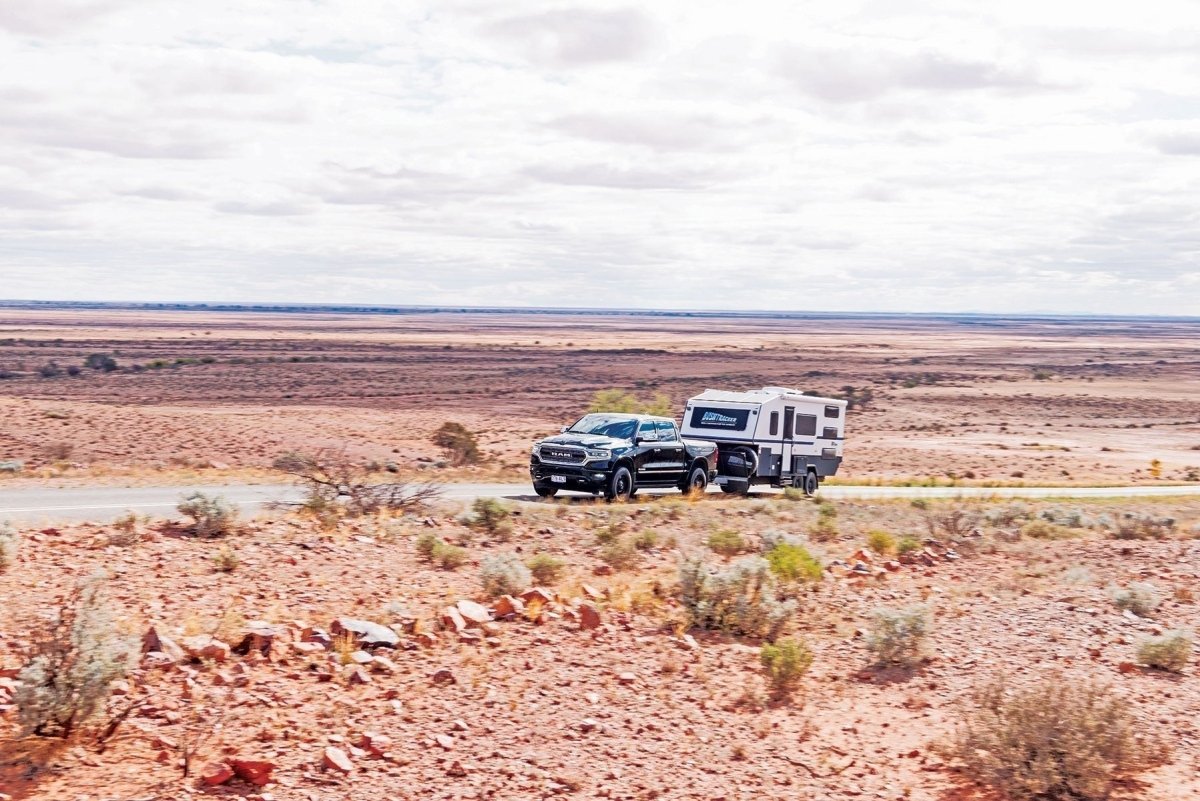
Gas, it seems, is an increasingly dirty word and there is a big push to replace gas with cleaner, more efficient methods of heating and cooking in our homes.
The Victorian Government has banned natural gas connections in new homes from 1 January 2024.
But it’s not just our homes that will be gasless in the future. Some forward-thinking caravan and camper van manufacturers have been making gasless vehicles for years and the trend is increasing across the sector.
Solar and battery management systems in some caravans today are highly sophisticated and enable travellers to camp off-grid almost indefinitely. Consumers have a choice of an induction stovetop inside the van, built-in or portable, as well as an induction hotplate in the exterior slide-out kitchen to replace the traditional gas barbecue. Heating and hot water needs can be electric or diesel.
The team at Caravan World has reviewed some breakthrough gasless vans in recent years so let’s take a look back at some of them.
Bushtracker 19 Compact
Back in April 2022 (Issue 622), Creative Director Tim van Duyl tested the Bushtracker 19 Compact. One of the big guns based in Queensland, Bushtracker has been building gasless vans for more than 10 years. A full custom builder, every van is unique.
Matthew Kurvink from Bushtracker said back in the early days, their gasless vans were heavily reliant on alternate fuel sources such as diesel cooktops, diesel hot water, even a diesel oven.
“However, now with the electronics being so good, our gasless vans are mostly electric with induction cooking, electric oven and electric hot water.
“That 19 Compact was built as a proof of concept to show that a gasless van could work and is something that is possible,” he said. “As a result of that van, and previous gasless vans that we have built over the past 10 years, we are seeing an increase in customers requesting this.
“I would say that well over 50 per cent of our total production is now gasless, and it is increasing every year.”
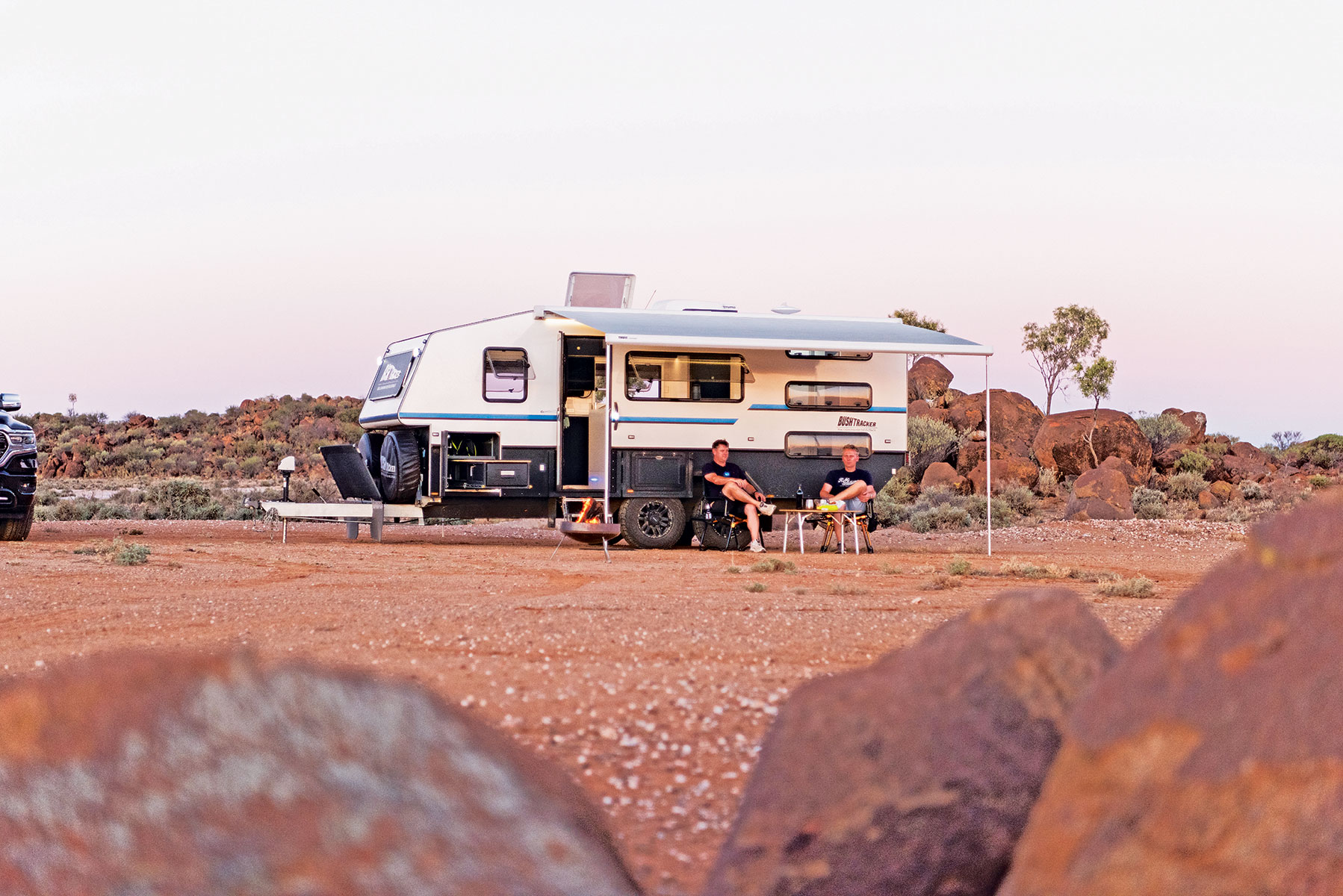

The review van featured 540W of 12V solar panels. This means you could see as much as 45A flowing into the Enerdrive charging system, but — and that’s a big but — that’s at peak and unlikely unless you’re out there keeping the dust off and you have perfect light conditions. Tim advised that you can expect 20A in average conditions, which is still enough to power the fridge, fans and lights.
Under the main bed is the brains behind the power and water systems. Designed specifically for the van and built by Enerdrive, it combines a 3000W Combi Inverter/Charger, the solar regulator, Active Balancing System (regulates draw and charging between the battery’s cells), a digital relay system, and a remote battery switch. It all combined to allow the owner to turn on the van and individual lights, AC and so on from an app or the main control tablet, monitor the charging statuses, draw, and tank levels as well as relax knowing the system has a tough failsafe. It also integrated into a CZone digital switching solution, the physical switches behind the controls, which above the usual ability to control appliances and lighting, can automatically open and close valves between the water tanks to balance weight across the van.
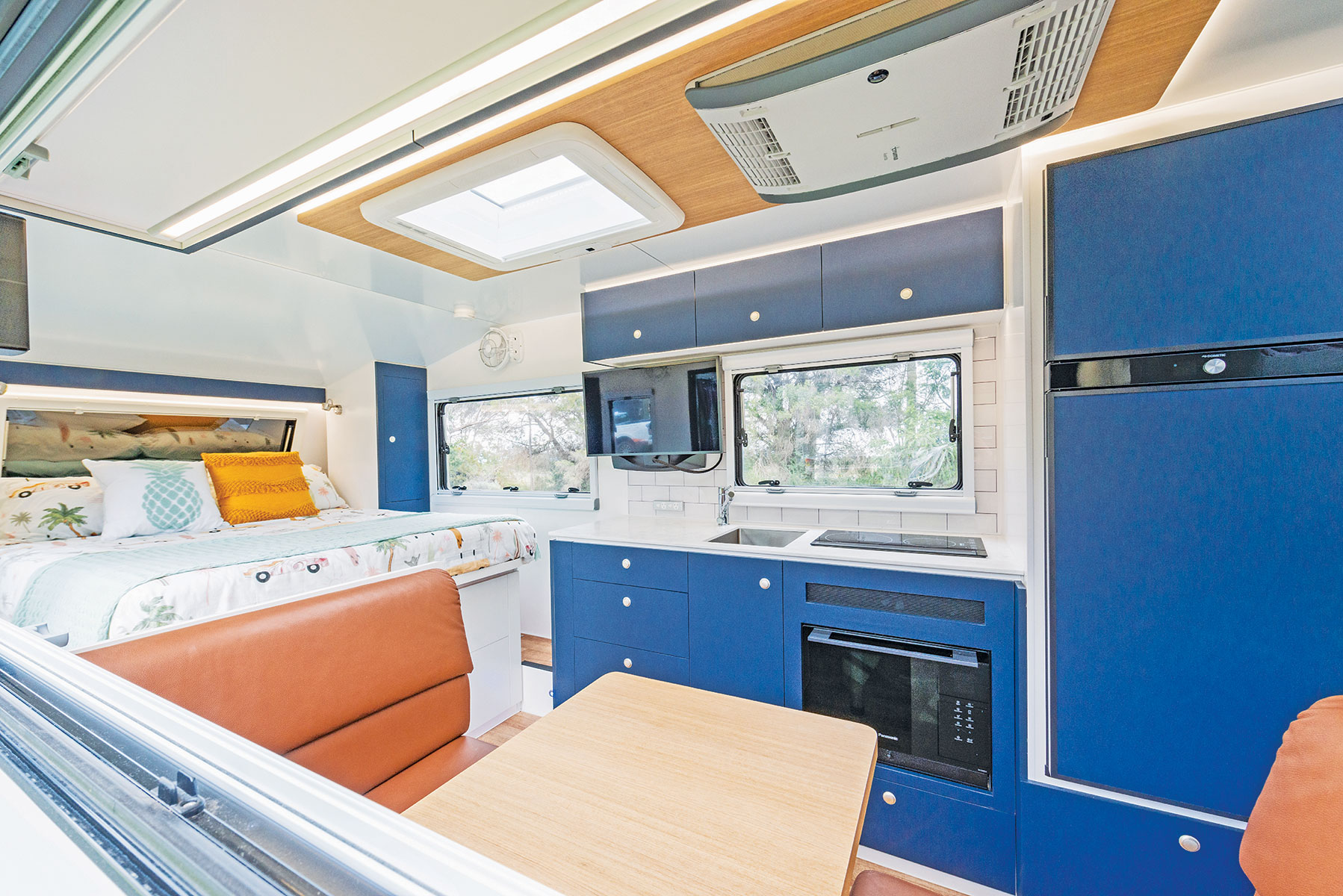
Matthew said that since Tim reviewed the Bushtracker 19 Compact, there have been advancements and improvements in technology and products available. There are higher quality, more efficient batteries now available and continual improvements in the electronics and charging systems.
“We now have the ability to heat the hot water without the need for fossil fuels — the van Tim tested needed diesel,” Matthew said. “Solar technology is always improving with lighter, more efficient panels. There are more options available for outdoor cooking and barbecues that do not require gas.
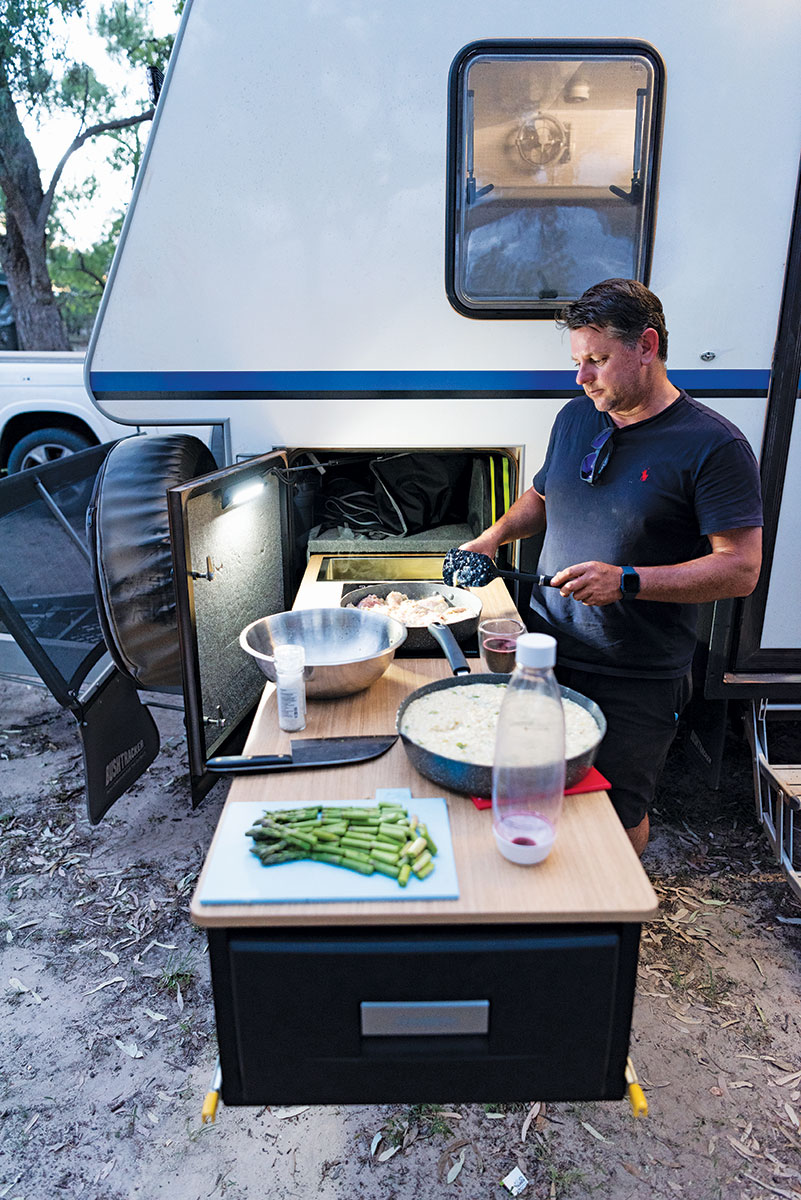
Matthew sees the end of gas in caravans as not an if, but a when.
“Currently it can be a bit cost prohibitive with the larger lithium systems required for the ‘all electric’ vans being significantly dearer and heavier than the gas alternatives. Over time I am sure that costs will continue to fall, and new technology will allow the gasless vans to become even lighter.”
Retreat ERV
The first gasless van ever reviewed by the Caravan World team was the Retreat ERV tested by Malcolm Street in July 2021 (Issue 613).
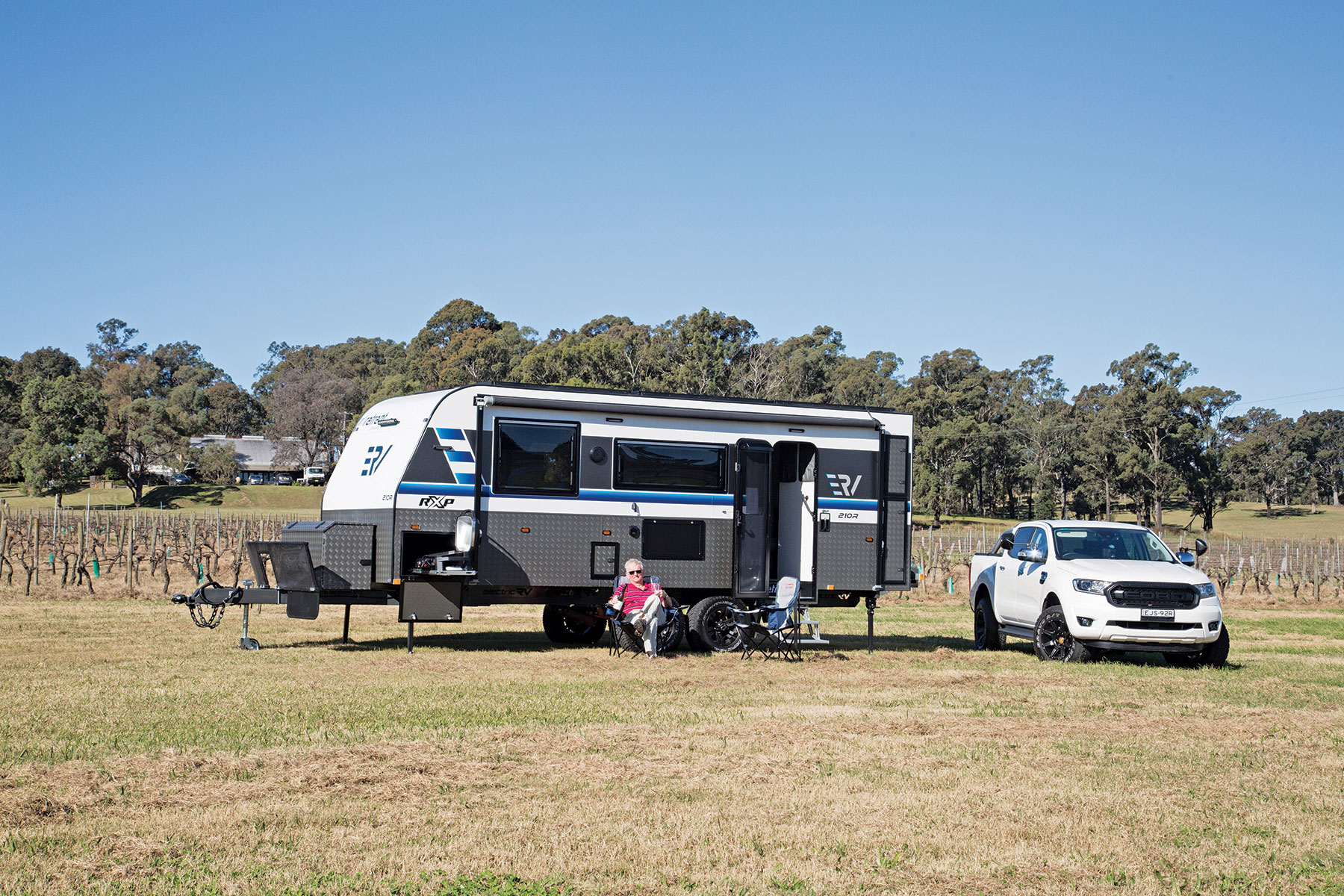
The Retreat team clearly had a great deal of confidence in the power system it had put together because everything in the van was electrically powered, including the induction cooktop, microwave oven, air conditioner and even the Weber Pulse barbecue.
The Retreat ERV boasted a 48V automotive-grade lithium battery rated at 14.3kWh, which was mounted under the van between the chassis rails. Apart from anything else, 48V was used because it reduces cable sizing and voltage drop issues. In case you are wondering about the 14.3kWh rating, it is roughly the equivalent of 20 x 100Ah AGM 12V batteries or 10 x 130Ah lithium 12V batteries.
A total of 2400W of solar capacity was mounted on the caravan roof and for 240V operation, the inverter was rated at 5000W making it possible to use the air conditioner, electric kettle and toaster simultaneously. One interesting feature was located in the front tunnel storage — a 15A outlet — it’s possible to do a bit of welding or plug in your neighbour’s caravan!
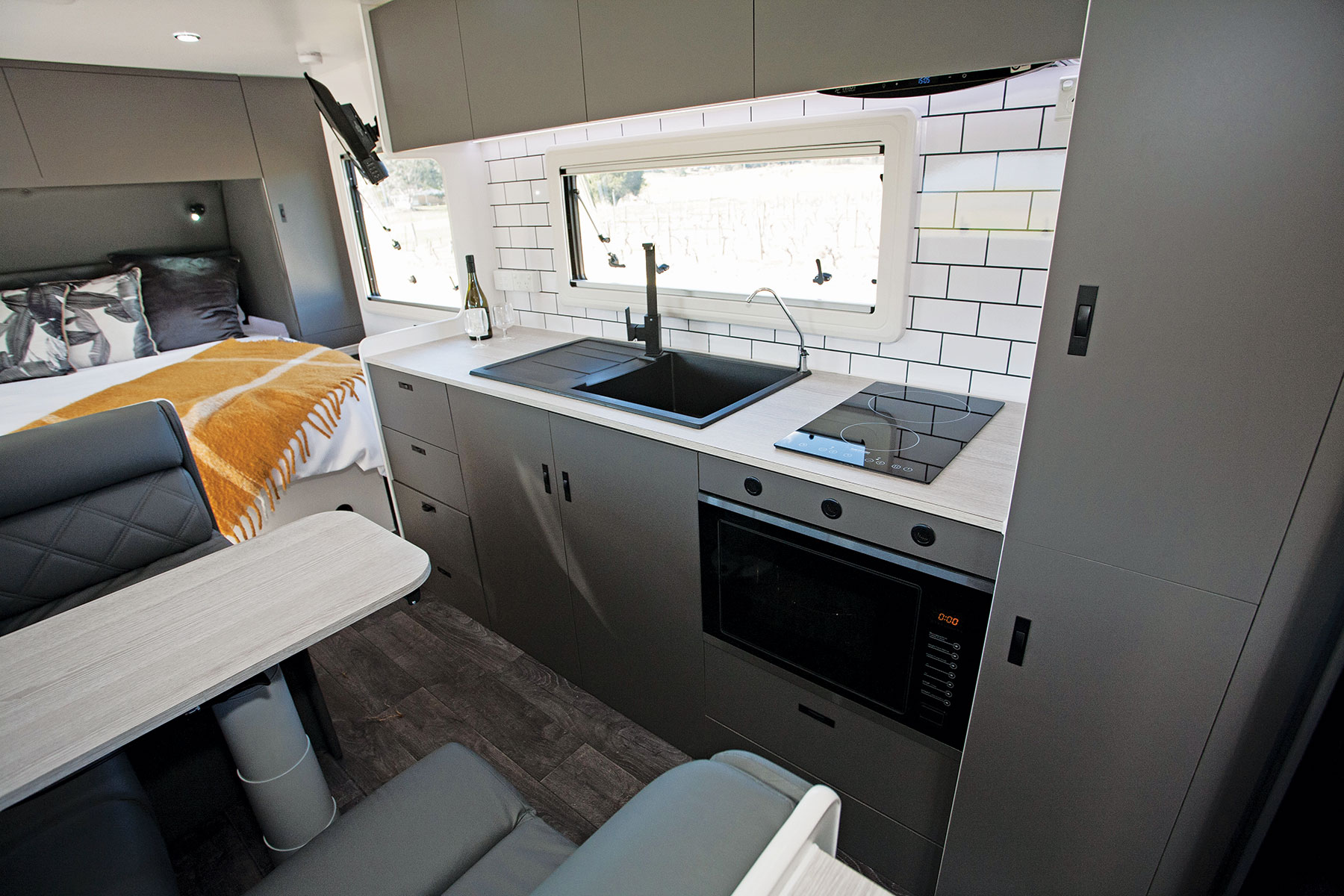
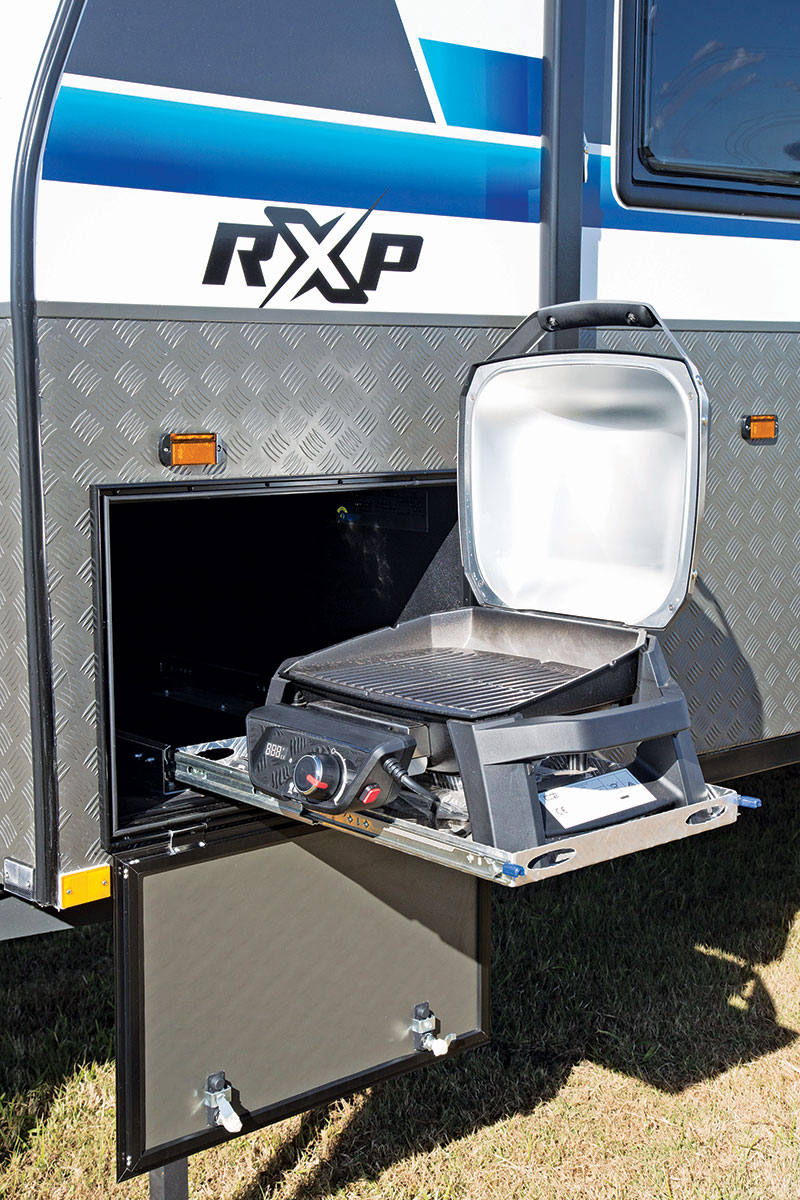
Malcolm reckoned anyone owning this van would be well advised to have an understanding of how the various 240V circuits in the van are switched, particularly those contemplating repairs or circuit modifications. The individual circuit breakers are to be found in the overhead locker above the kitchen bench. In addition, the circuit breakers for the 240V grid supply and the 240V inverter supply are located underneath the front dinette seat with the inverter. For the tech heads, both these circuit breakers use residual voltage device (RVD) protection rather than the more usual residual current device (RCD) aka ‘safety switch’ protection. The former being more effective with inverter or generator power.
Euro Glider
In early 2023 (February — Issue 632) Malcolm reviewed the tiny Glider by Euro Caravans, a fully electric little pocket rocket light enough to be towed by a small SUV — in his case a Subaru Forester.
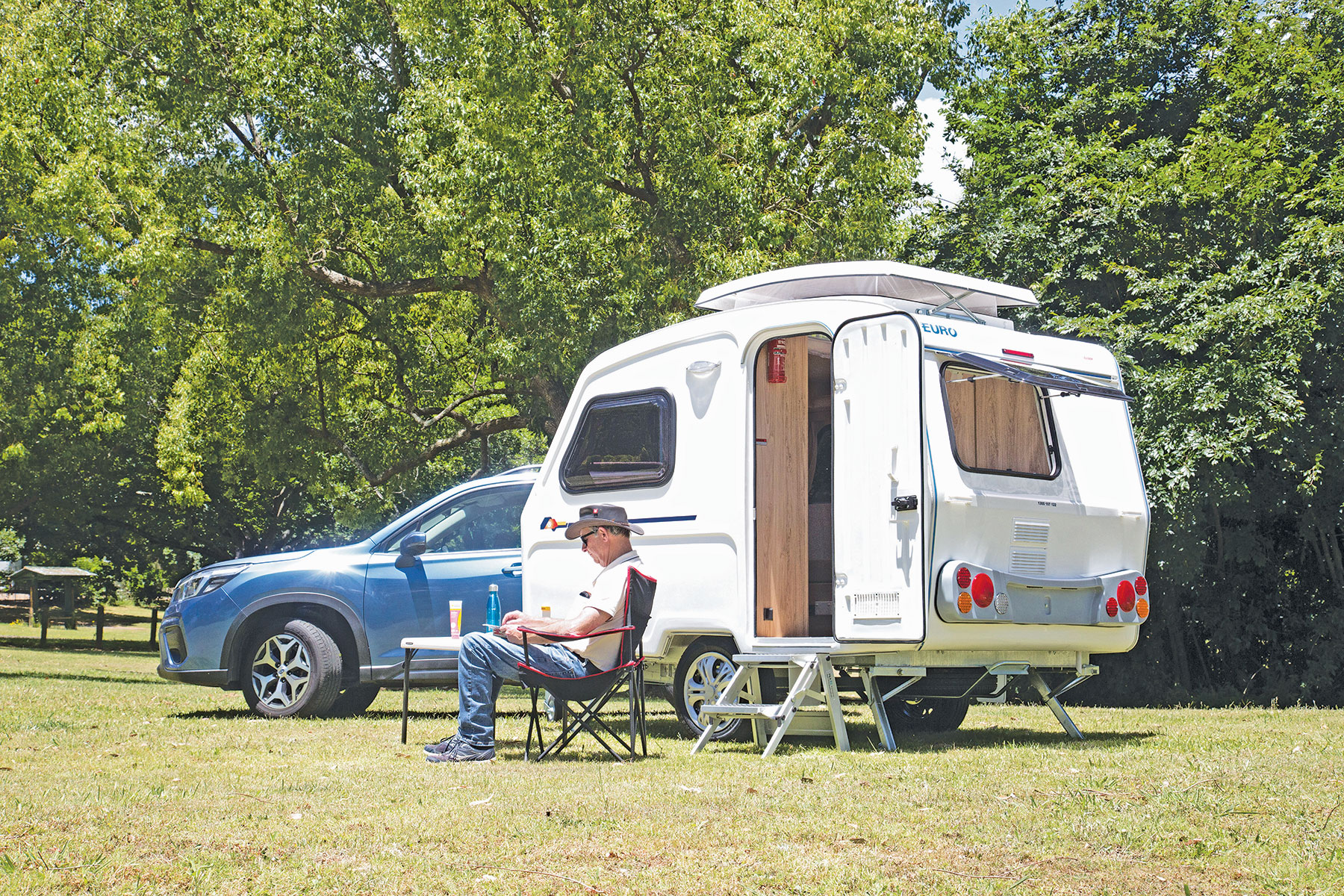
On this van, both the 100Ah battery and the Truma TT2 5L 240V water heater are found under the offside seat. However, in future models, the battery will be shifted to an outside location and a 35L water tank will be in its place. There’s no air conditioner fitted to the van, but an option offered by Euro Caravans is a portable Zero Breeze air conditioner.
As small kitchens go, this is typically European in size. There’s just a small stainless steel washing up basin and an under-bench LG Alpicool 58L fridge. Instead of a gas hob, a portable Westinghouse induction plate, rated from 300W to 1500W, does the job. A double cupboard sits beside the fridge and low-height overhead lockers are in the air space above.
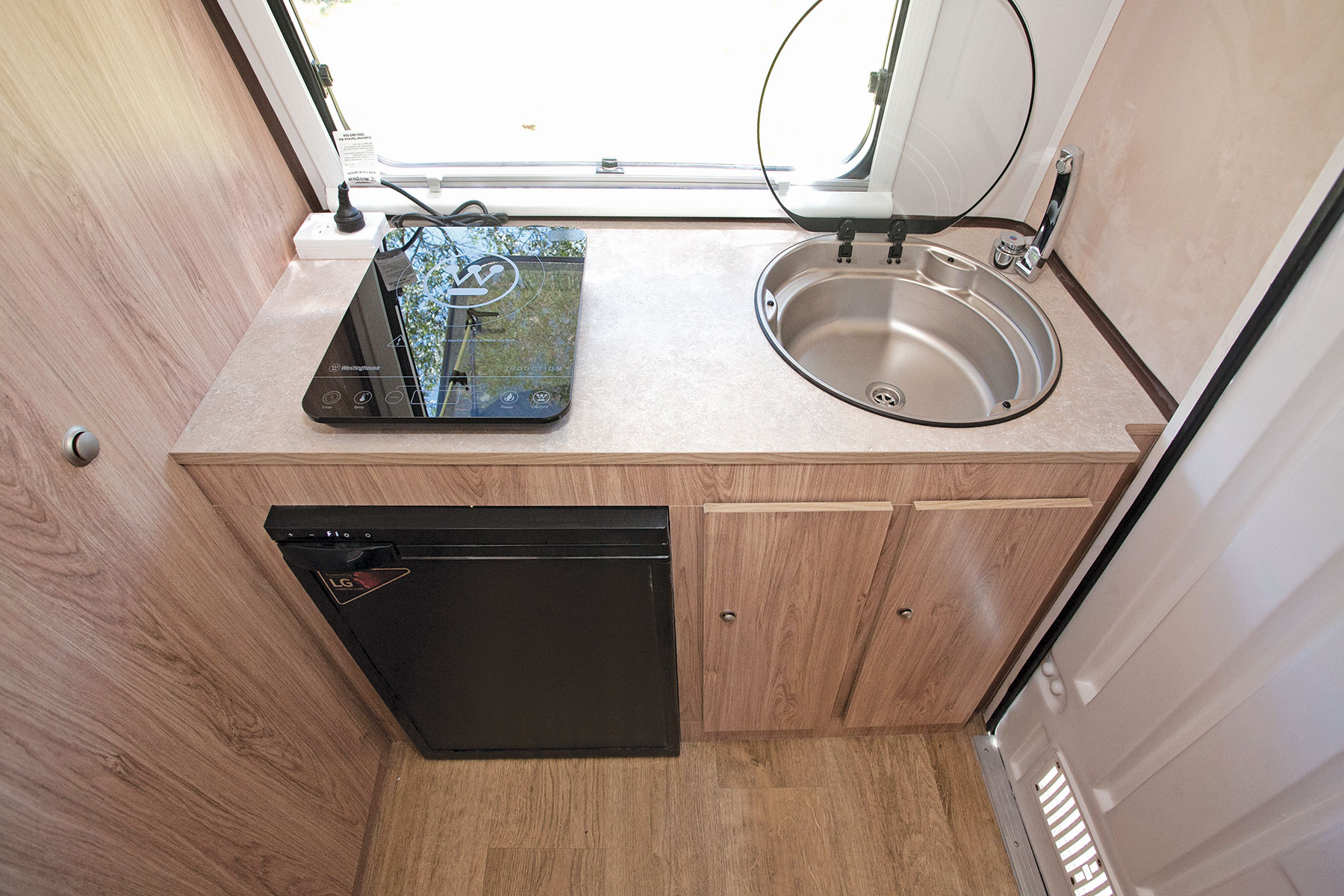
Earlier models of the Glider had LP gas as standard. The team at Euro Caravans has decided not to do that, instead relying solely on electrics for cooking and water heating. While that’s fine in a caravan park, it’s more of a problem when remote travelling. Options offered to solve that issue are items like a Bluetti EB70 716Wh portable power station and a 120W solar panel for charging that and the house battery. Malcolm didn’t have the opportunity to test this out at the time, but it’s certainly worth a thought. Although there’s weight saving in not having a gas system, the alternative does add weight. The Bluetti EB70 for instance, weighs 9.7kg.
Bruder EXP-8
Caravan World Editor-At-Large John Ford was as excited as a kid in a lolly shop as one of the first writers in the country to review the incredible Bruder EXP-8 (Issue 633) in March 2023.
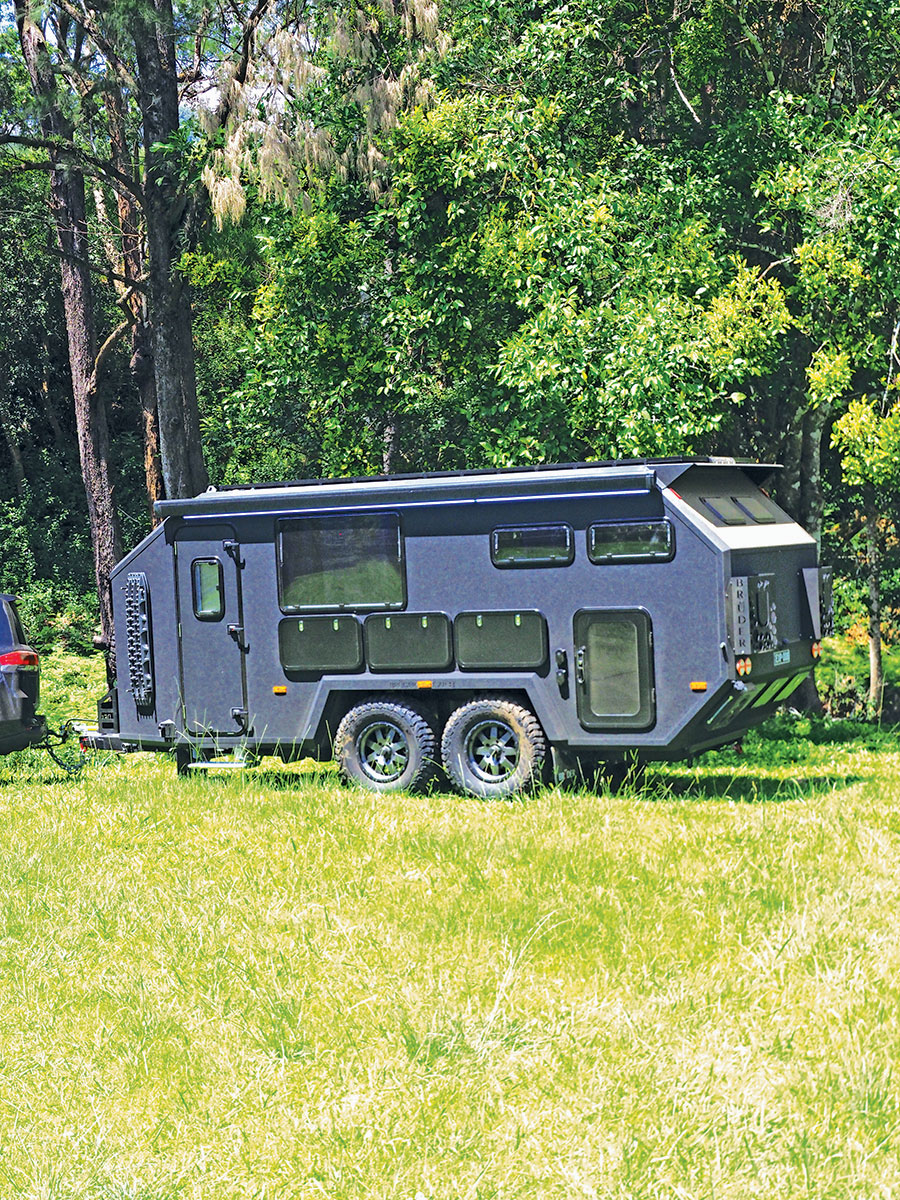
Bruder was born out of the desire of brothers Toby and Dan Bosschietor to build a better offroader after five years of importing South African camper trailers. From a young age, the brothers were instilled with a love of the outdoors and the travel lifestyle.
Since its public launch in 2016, all Bruder models have been gasless except for everything outside the EXP-4, which has a gas cooktop and electric as the option. Dan said this does take a little convincing with some of the clients who are used to the way certain things can be easier to run with gas, but that perception is certainly changing.
The Bruder is all about getting off-grid. So, self-sufficiency is a prime consideration, and the level of electrical power on hand is impressive. The system is Victron Energy based but with all wiring completed in-house in a dedicated workshop. Up top, the roof is covered in solar panels for 1600W of charge through an MPPT charger to a 48V lithium battery pack that can deliver 16.7Wh to the van through a 5000W Victron inverter.
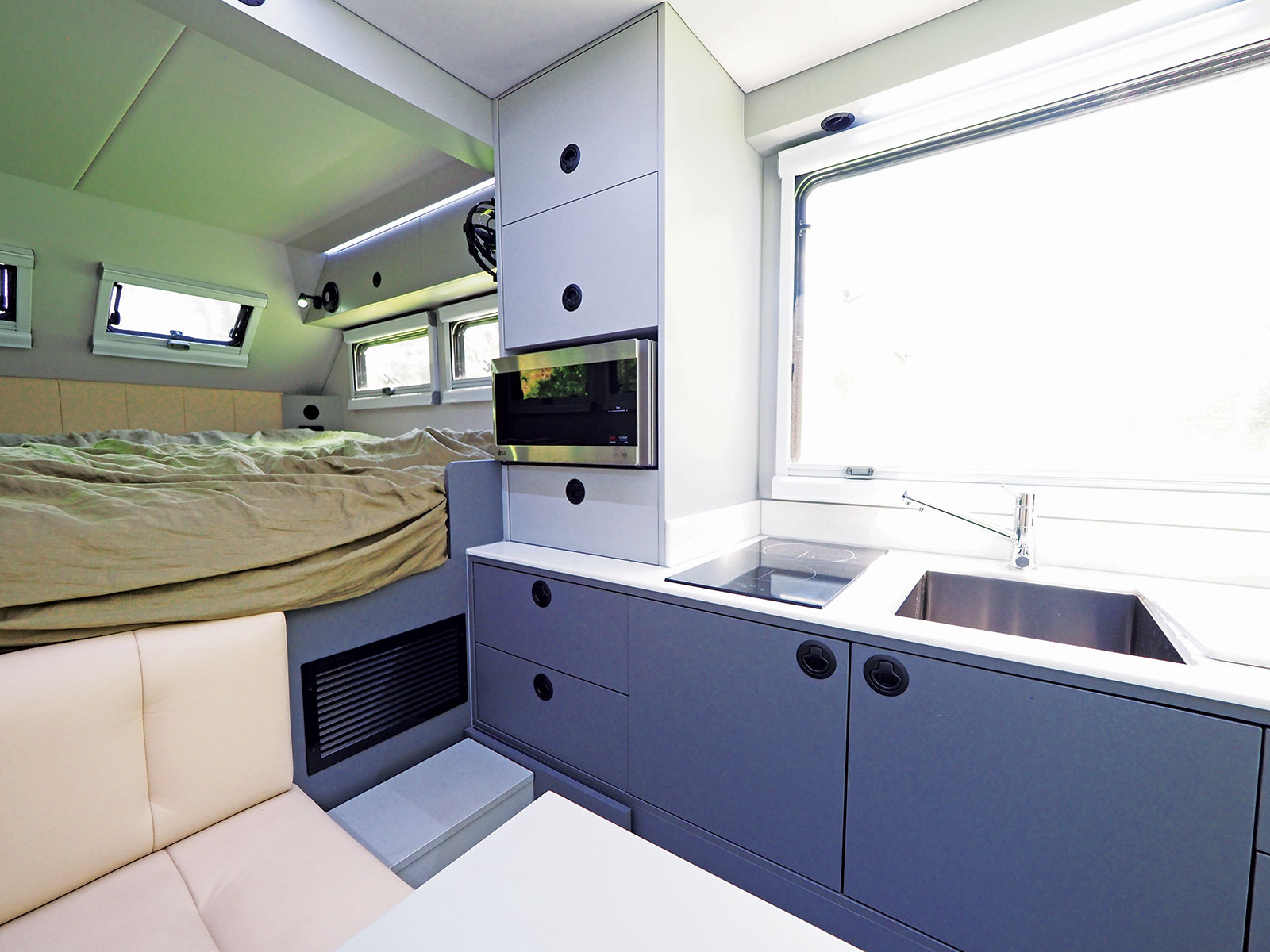
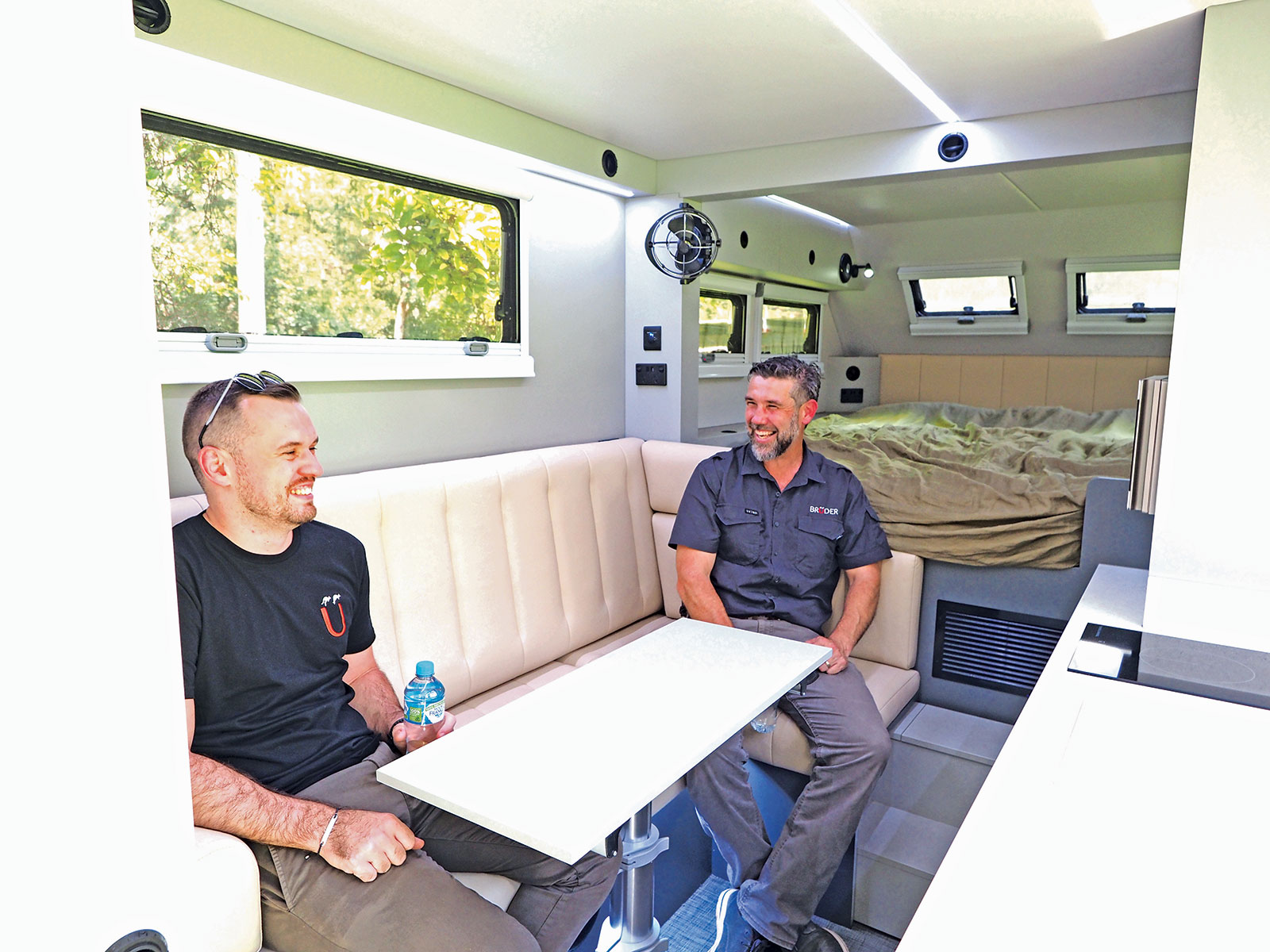
Dan said there has been a substantial improvement in ‘off the shelf’ electronics products to allow for bigger power draws and power regeneration required for the move away from gas, but Bruder prefers to develop its own systems incorporating its own initiatives.
“We generally use 48V for our battery storage as it is simply more efficient than the 12V setups for conversion to bigger high draw 240V equipment,” he said.
“One of the biggest things that we see in the industry is the concept that as soon as you are using lithium batteries that is the holy grail. Just like anything there are good batteries and there are not so good batteries. If a customer is looking at a system to go fully off-grid you need to look very closely at charge and discharge rates and if your battery can handle the amount of amperage that you are trying to charge or draw from.”
So powerful are the electrical systems in the Bruder vans that some clients have used them in emergency situations, such as recent floods, to keep appliances in their houses running.
Wonderland RV XTR 2100F-C 2 Bunk
In April 2022 (Issue 622) Tim reviewed the Wonderland RV XTR 2100F-C 2 Bunk, built by one of the Wonderland bosses for his family. It’s a big (21ft), heavy (4400kg), expensive ($201,000 with options fitted) van but Tim reckoned that in a few years these headline numbers will be common and more affordable thanks to pinnacle builds like this doing the testing and research.
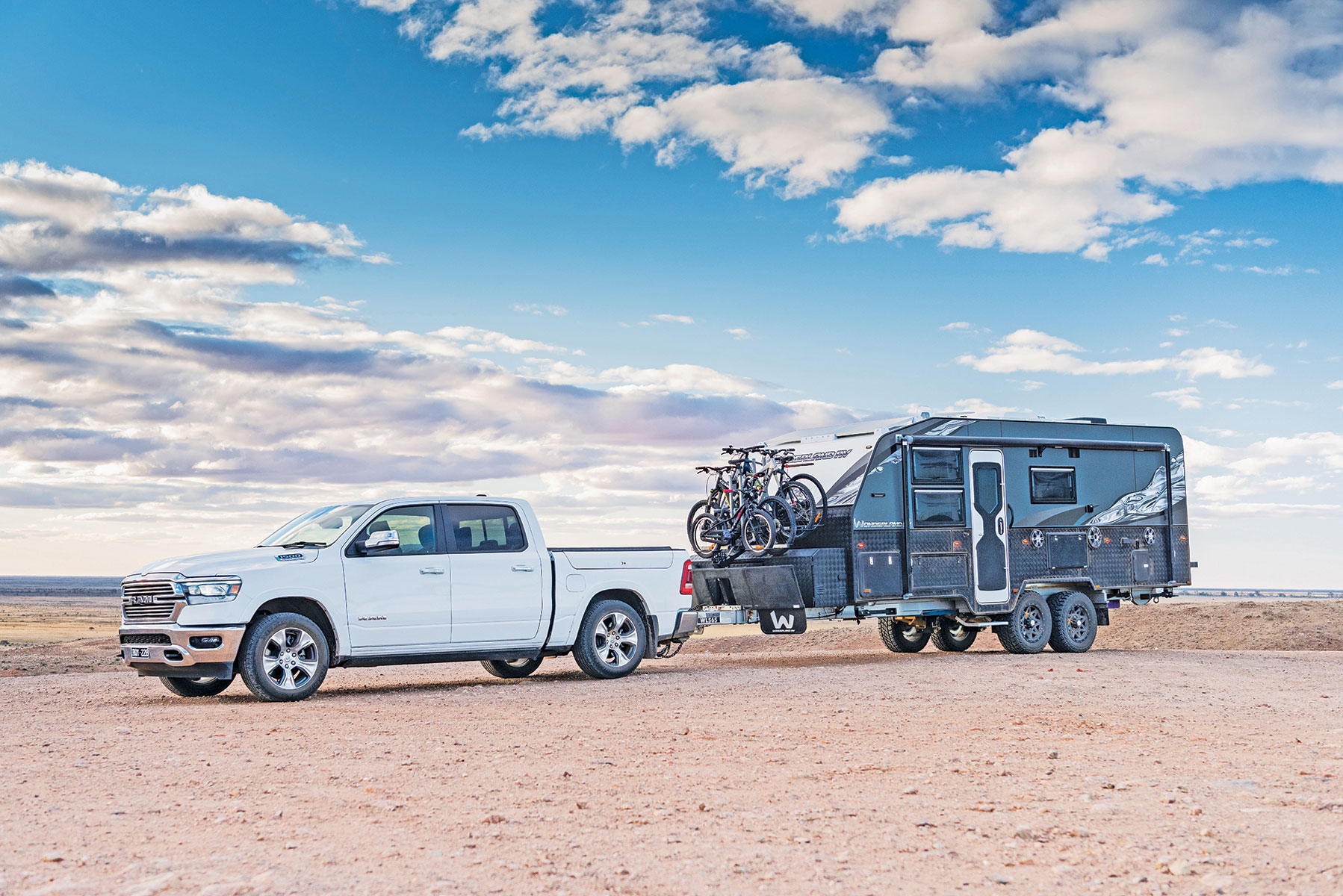
Here’s what Tim had to say about the Wonderland:
Starting with the power, it runs a 24V system built by Enerdrive. There are 1200W of 24V solar panels feeding into 800A of lithium batteries on the roof that in optimal conditions will produce 50A at 24V. Regulation is by two 60A Morningstar MPPT controllers and an ePower 24V, 30A DC-DC handles the incoming from the Anderson plug after it is converted by a 12–24–12V transformer. An Active Balancing System controls charging to individual cells in the Enerdrive supplied batteries and a Simarine 50A SCQ50 shunt module monitors four channels at up to 35V and passes on the state of charge (or draw) to the easy-to-read display. It can also be integrated into apps.
Two inverters run different parts of the van with a dedicated 2000W unit for the two Thetford twin induction cooktops and a second 3500W ePRO Inverter Charger that does what it says on the label as a charger and inverter. The ePRO is a new piece of technology that can charge your batteries from AC and flick over near-instantly to provide AC to the plugs throughout the van from the DC battery bank. If you are using the TV or a laptop and the AC fails, the ePRO will flick over to the battery without interrupting the supply of power; it is a clever piece of kit.
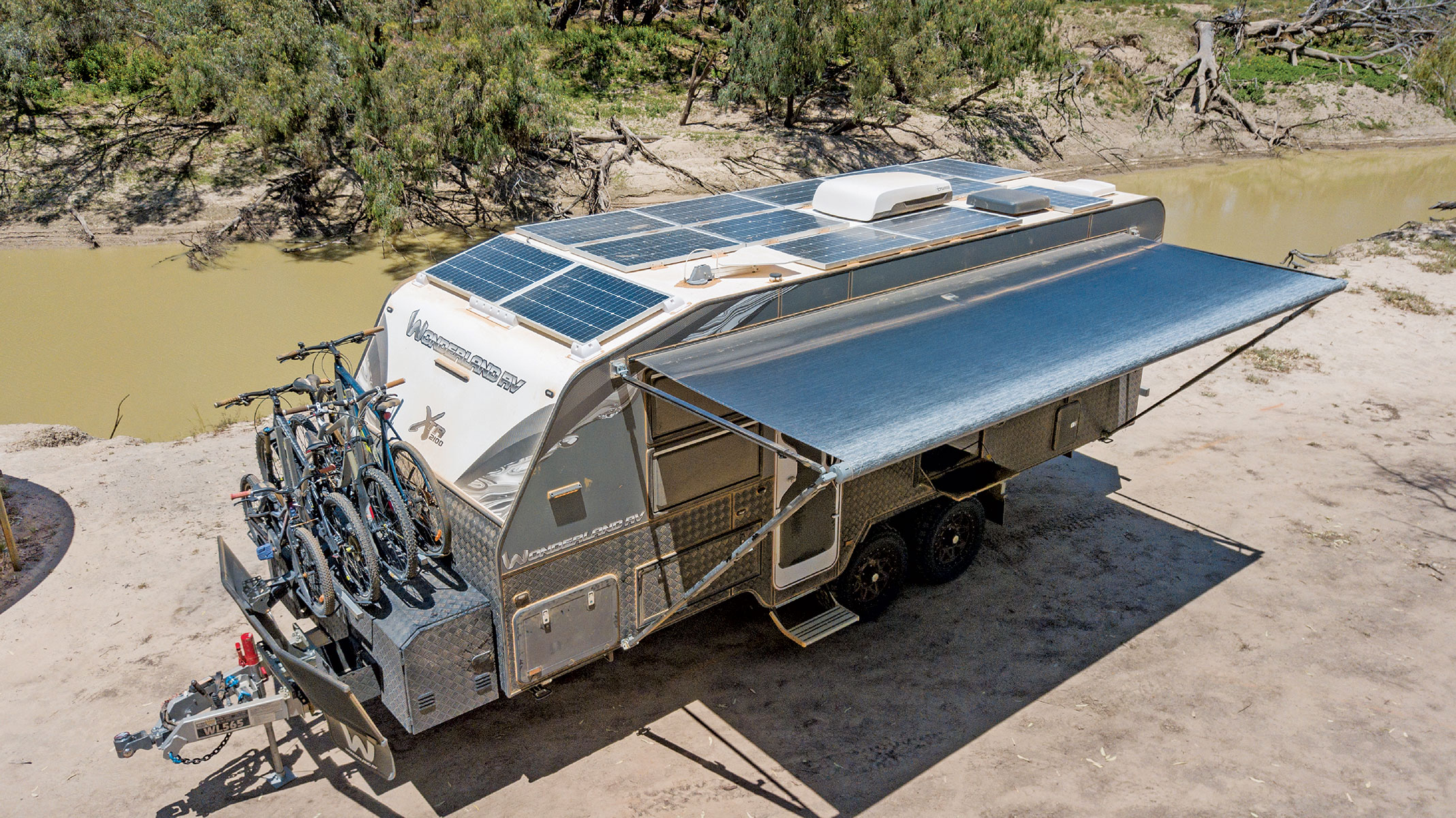
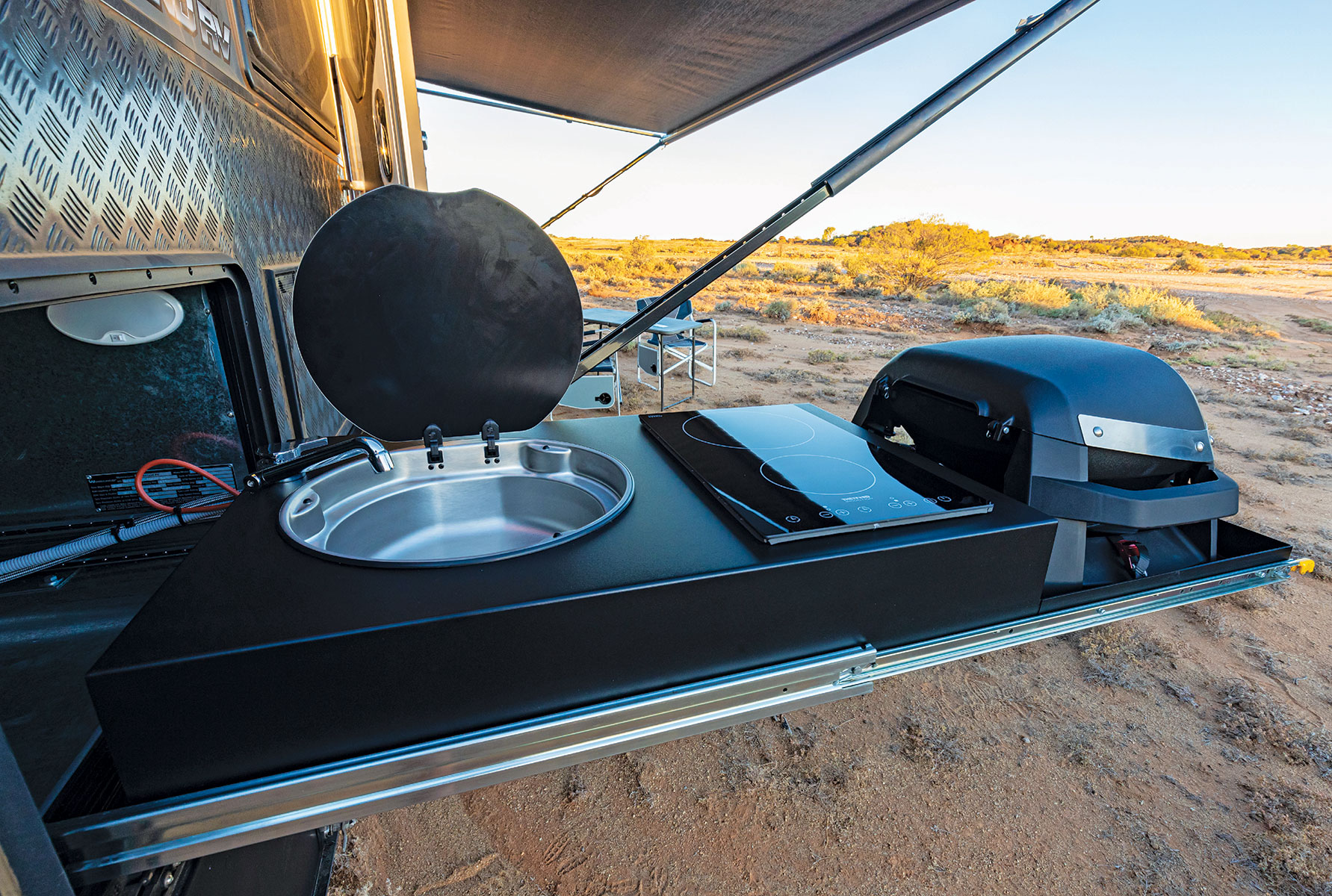
So, what does that all mean? Putting it in terms of the most power-hungry appliance, the AC, once the Truma Aventa has settled on a comfortable temperature around 10 degrees under ambient, it will draw about 800W at 12V or about 67A. Tim saw a peak of 80A on an early part of the test, in peak conditions, so it looks like this is one of the first vans we have seen that could theoretically run the AC without drawing down on the battery — if you have the fridges, TV and other appliances off and keep the panels clean, that is. I expect, in real-world conditions and use, you would use the AC for a few hours a day only while having the fridges and other devices on constantly. Do that and this set-up should run indefinitely.
A diesel Eberspacher Hydronic Water Heater gives near-instant hot water and doubles as a space heater. With diesel being substantially cheaper than LPG, not to mention much easier to carry, and this style of HWS being so efficient, it’s not surprising to see them starting to gain popularity.
There’s a 244L compressor fridge and an induction cooktop inside. Outside there is a 40L Engel on a slide-out from the massive front toolbox. There is also a slide-out kitchen that houses the second Thetford Induction cooktop, a decent-sized bench and sink plus the Weber Pulse barbecue.
Spinifex Electrex Premier
Readers were first introduced to the Spinifex Electrex Premier in August 2022 (Issue 626) in a review by John Ford and again in June 2023 (Issue 636) as the winner of Caravan of the Year 2023.

Built for company owners Steve Thompson and his wife Elise with a powerful electrics package to suit their off-grid lifestyle, the Electrex debuted at the last year’s Brisbane Go Caravanning Show, where it marked its place at the pointy end of self-sustainable off-roading.
The electrical system has enough solar-generated power and redundancies to run domestic appliances effectively for days. There is enough electric power to do away with reliance on gas completely.
The essence of the Electrex is a thumping 240V power supply for an (almost) unrestricted off-grid lifestyle. The OzX Corp DSC system is an Aussie innovation brought to life by the company’s founder Andrew Huett. It is a complete package of supply, charger, inverter and battery that’s a plug-and-play option with benefits of relatively light weight and redundant safety. By creating a fully integrated package, he has removed the possibility of mismatching components and eliminated the blame game if something fails across various brands. In addition, battery and electronics boxes are replaced easily in case of problems.

On the roof are four 470W commercial quality SunPower panels for a total of 1780W feeding a 14.3kWh (kilowatt-hour) lithium battery tucked up between the chassis rails under the floor. Some of this jargon might sound unfamiliar. However, Andrew explained that he describes his system in the universally recognised watt rating rather than by the outdated amp-hours value we see on most 12V batteries. Watts is a universally measurable unit regardless of volts or amp-hours and is accepted across many technologies, including vehicles fitted with hybrid and internal combustion engines. Kilowatt-hour (kWh) refers to the amount of energy used in an hour. As an example, you could run a 1000W appliance on this van for 14.3 hours before the battery needs charging.
The Electrex brings new meaning to off-grid living by allowing any number of domestic appliances to run from the power bank. Coffee machines, air fryers and Thermomix cookers don’t have to stay home. Being able to run an air conditioner at night in stifling weather is a major attraction because even with effective insulation it can get pretty warm in a van.
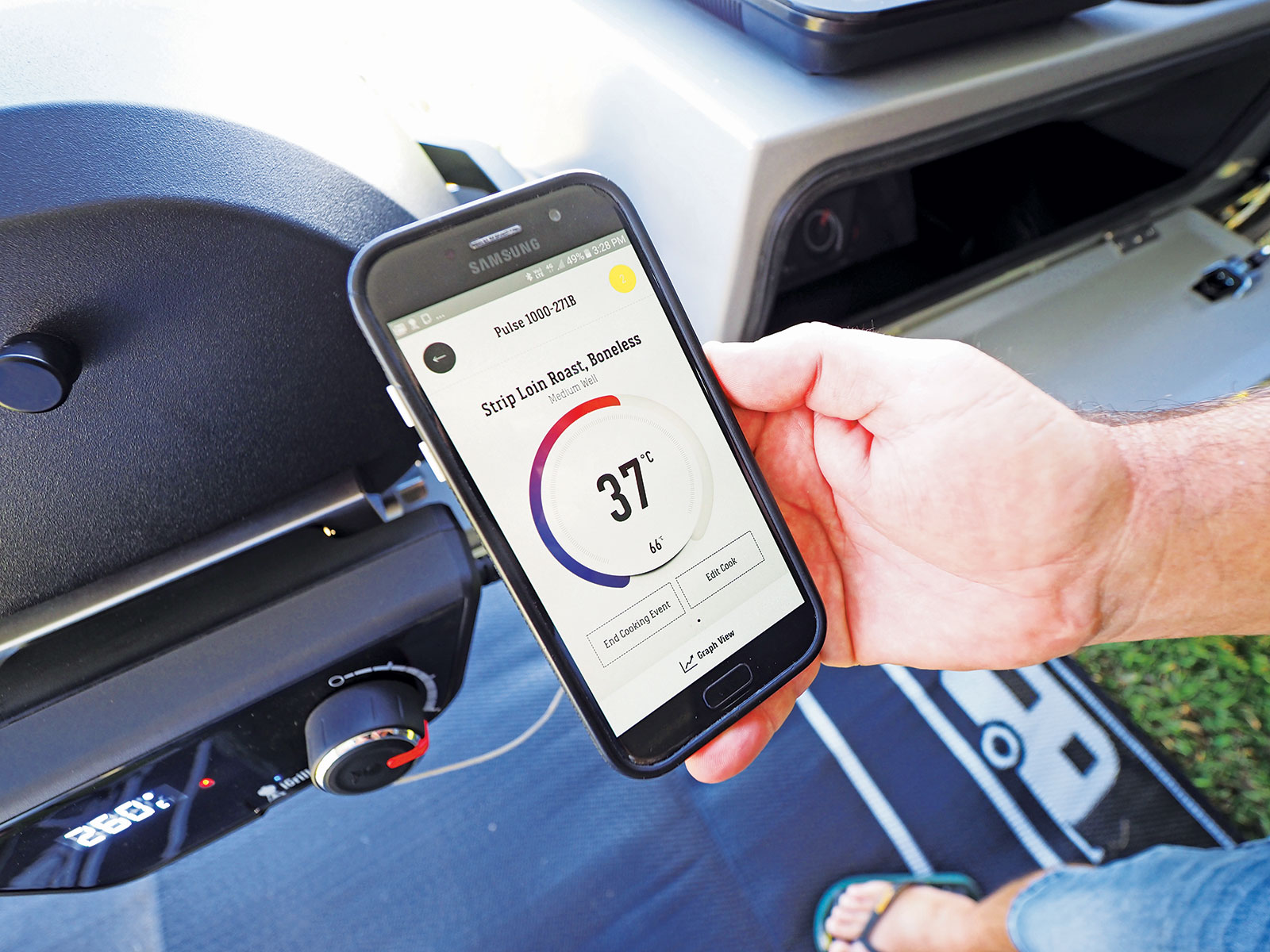
Most inside cooking will happen on a 27L combination convection microwave/air fryer. The kitchen bench is a wide expanse of preparation space because the couple uses a portable induction cooktop, so it’s only there when needed and stored in a dedicated area when it isn’t.
Evernew RT-X 35 'Gasless'
In September 2022 (Issue 627) Tim got to have a look at Evernew Caravans’ RT-X 35 ‘Gasless’, a caravan built in Melbourne from the proud almost 60-year-old company with one purpose — give the public an affordable gasless caravan that will take them outback in real comfort. Here’s what he said:
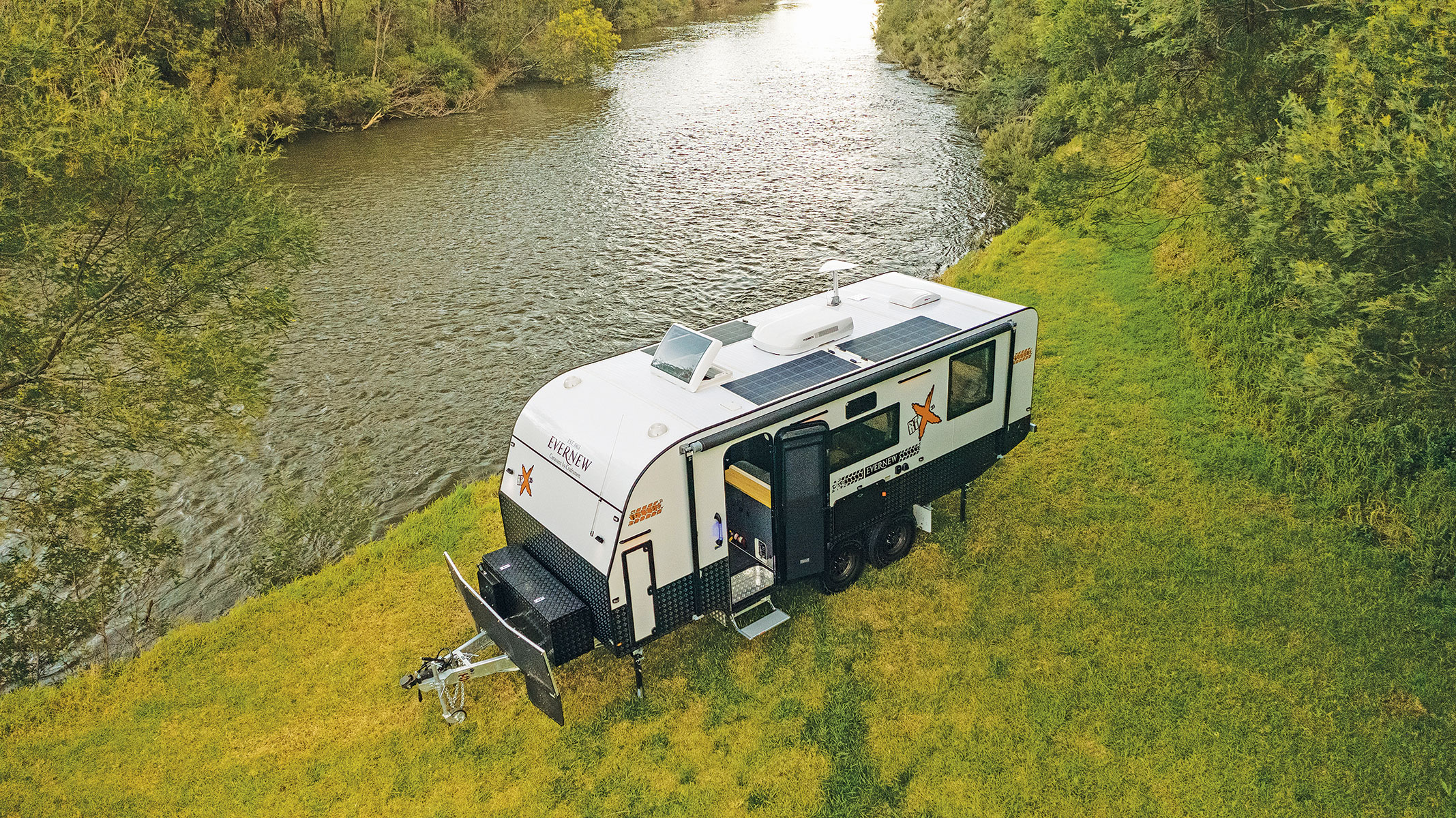
This van uses a brand not often seen in caravans to power its systems and give it its ‘gasless’ credentials. REDARC, which supplied the power and brains behind the build, is a proud, award-winning brand based just south of Adelaide in SA. Well-known in camper trailers, REDARC also provides technology for defence and industrial applications. One thing tying these diverse markets is excellence.
REDARC received the first Gerry Ryan OAM Award for Innovation from the Caravan Industry Association of Australia (CIAA) for its RedVision Total Vehicle Management System or TVMS which is what underpins this build.
TVMS is a powerful control unit that plugs into the charger and fluid level monitors and has the capability to control powered systems throughout the caravan by app or the display unit. BMPRO and Enerdrive have similar systems, but Evernew owner, Dani Bib, believes the REDARC is the simplest to install and the most rewarding from a user point of view.
The system consists of two 200A lithium batteries, a REDARC Manager30 charger, a BCDC1250D charger, a 3000W pure sine inverter and the TVMS. Combined, the devices power and monitor all functions of the caravan from the front step to the Thetford induction cooktop. The app is quick loading and simple to use with the ability to ‘fire up’ the caravan when within Bluetooth range, turn on lights, pumps, the air-conditioner and the inverter. From there you can monitor the state of charge (or discharge) of the battery bank which is fed power from 720W of combined solar panels. One cool thing about the system is that it prioritises where it is taking charge from, meaning even if plugged into air-conditioner, and if the sun is shining, it will pass on as much solar power as possible to the batteries.
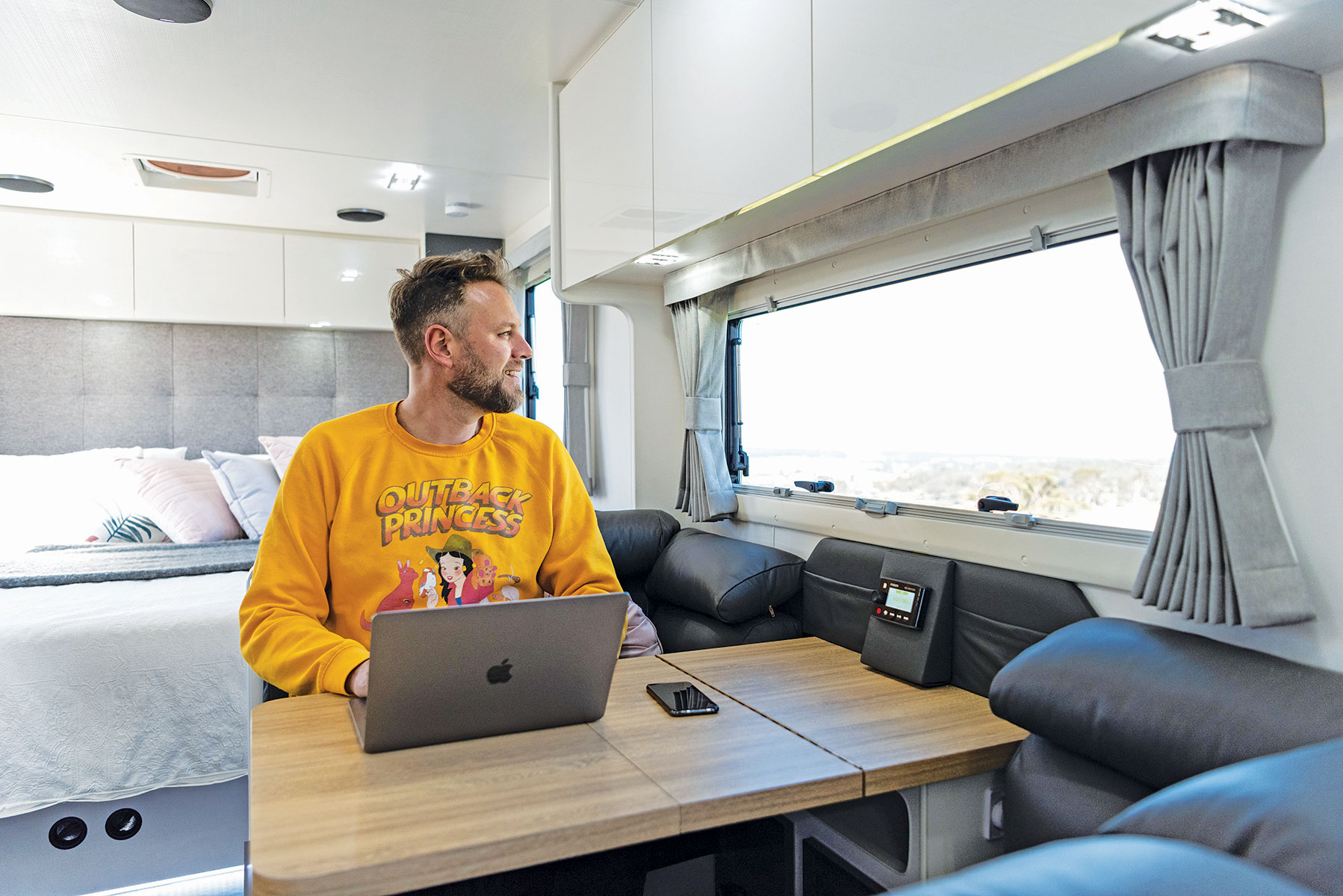
There is an upgrade coming to the REDARC Manager30 which is being replaced with a more capable charger.
The reviewed van used a Manager30 rated to 30A, capable of charging the batteries off 240V AC as well as having DC and solar input. The Manager30 pairs with the BCDC50, a 50A 12V charger with solar inputs. Together, these have a peak charging capacity of 80A which is plenty to rapid recharge while driving or when plugged in at a holiday park.
The solar system has a theoretical maximum of 60A, which you will never see. Expect more like 20-30A on a typical day which for around six hours will pump in around 120-180A of power back into the system meaning you won’t have to be too careful with your power use in this van, you should be able to relax knowing you have the capacity in solar and charging.
A detail in the TVMS Tim really liked is how it prioritises solar charging as well as maintaining peak charging power while appliances are in use. To explain this further, even if you are drawing around 20A through your fridges and some USB ports, if the capacity is there through solar and the car’s DC charge from the Anderson plug, it can still be pushing in up to 80A into the batteries while the van is consuming 20A.
The rumour mill is that the incoming replacement charger is rated to a healthy 100A and will be a single unit removing the need for the Manager30 and BCDC combo.
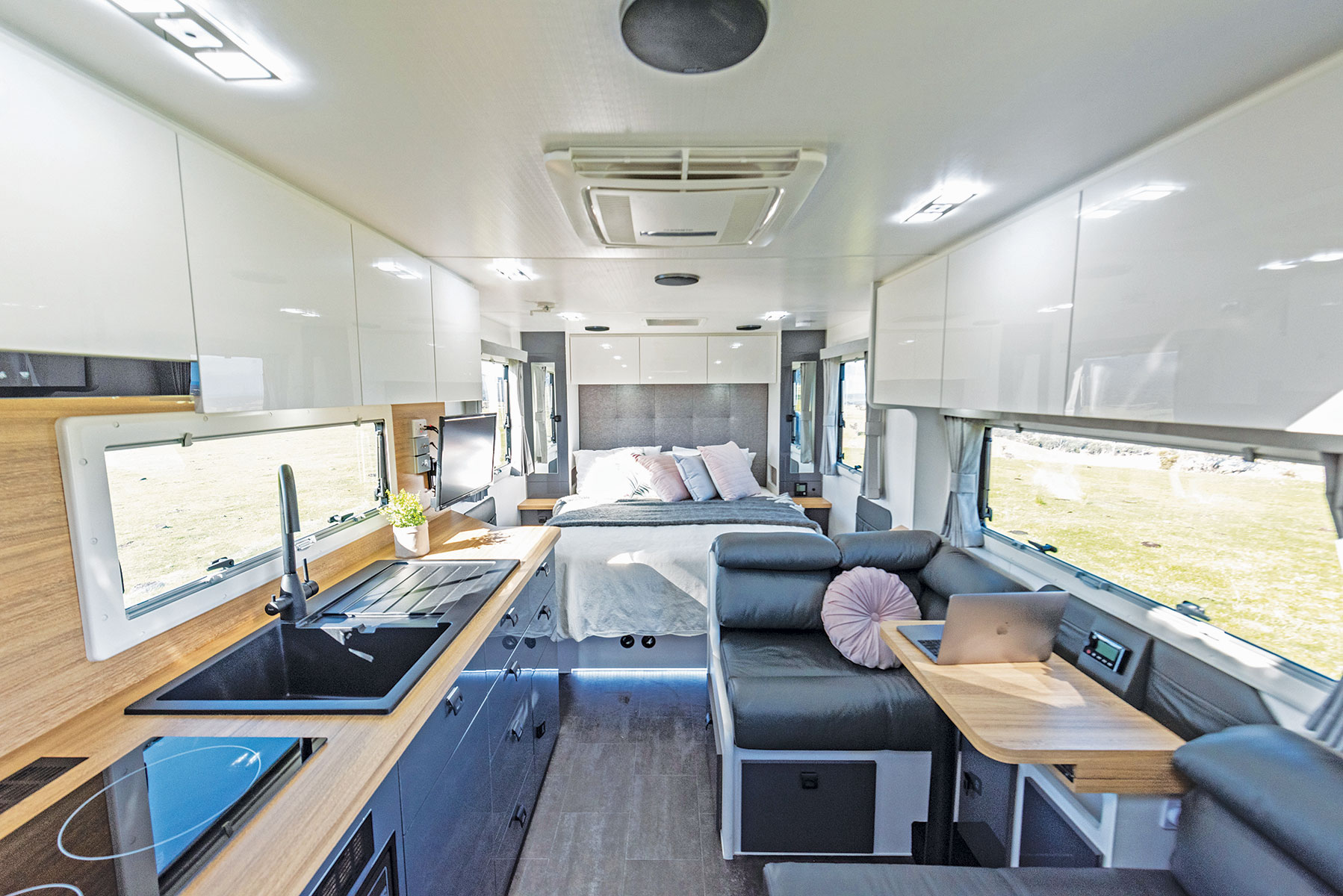
And can you run the air-conditioner off the inverter and battery bank? Yes, just. The IBIS4 will draw around 60A when running around five to eight degrees under ambient conditions which means you could run it for it a couple of hours to take the edge off the heat, but you would need to be confident the next day’s sunlight will be good or know you are planning to drive to recharge the bank through the car. One thing you can do, but again, only just, is fire up the air-conditioning while driving to cool the internal temperature of the van down, but it will possibly draw a bit from the battery so keep an eye on the app and your state of charge.
Lyfe RV19 Offroad
In April 2023, John Hughes reviewed the Lyfe RV19 which is bucking the trend with modern manufacturing methods, a different approach to layouts and power systems.
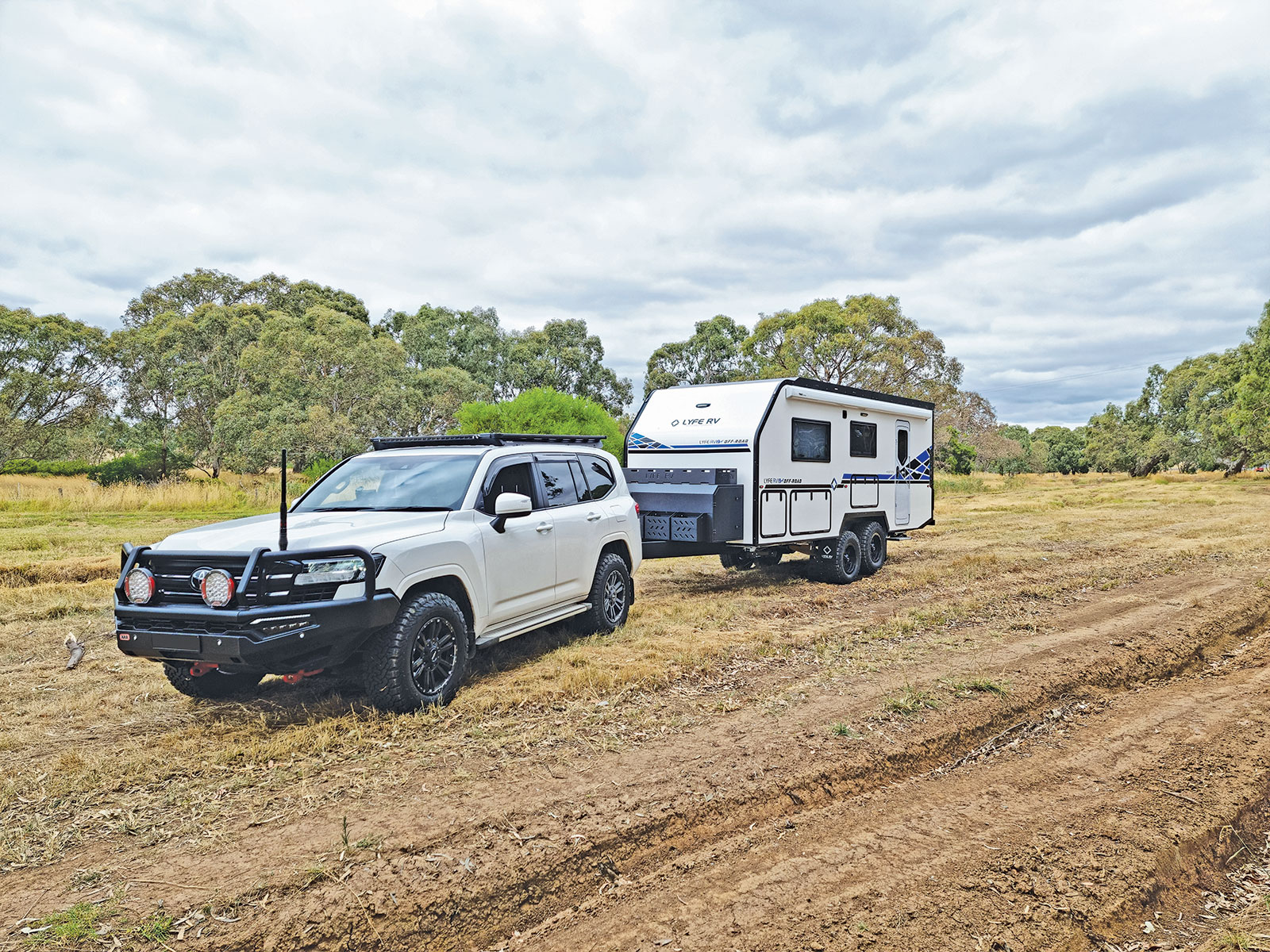
Lyfe RV has gone the whole hog with a 48V system powering the entire van, allowing extended use of all appliances off-grid and eliminating the need for gas. Put simply, 48V setups can be far more efficient than 12V systems, allowing you to put more power in quickly and have access to more power to run more things for longer.
The system is fed with 1210W of solar panels and 12–48V 1.5kW can DV5 DC-DC charge converters charging from your car while it is running.
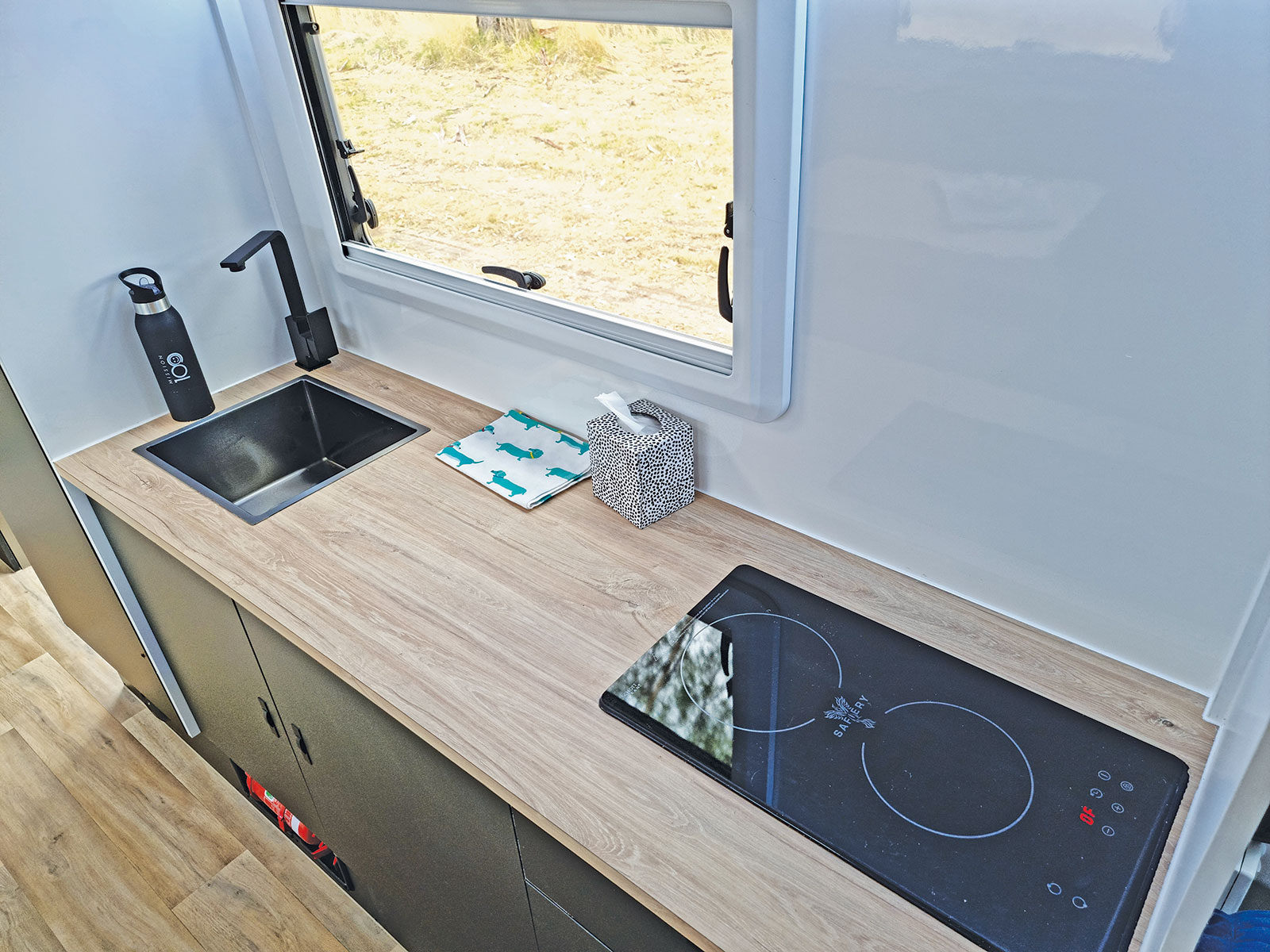
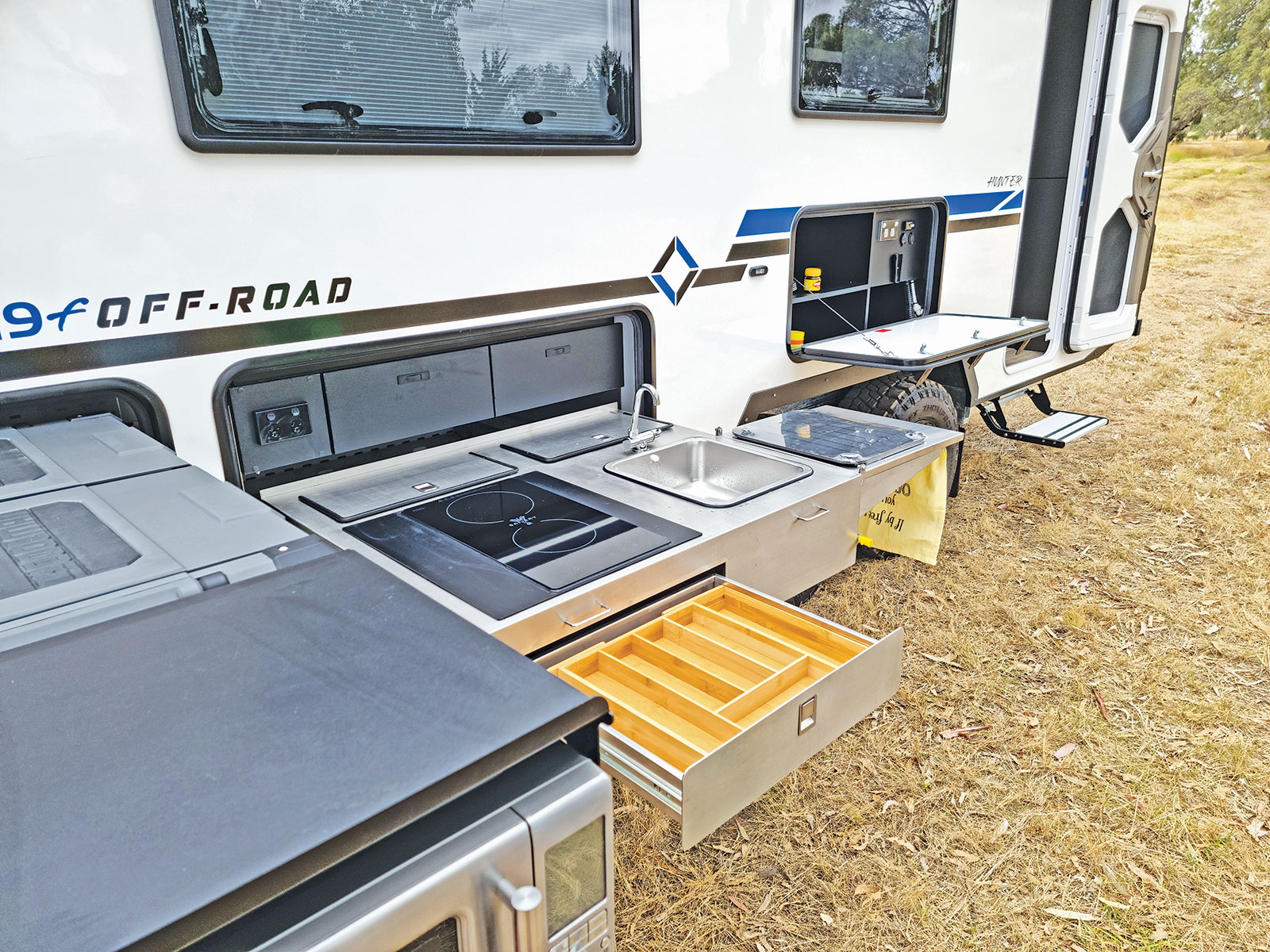
A bank of Safiery Lithium batteries total 800Ah and give you plenty of storage, and a 6000W inverter delivers that power to run appliances. John was told by the manufacturers they could run anything they liked, including the air-conditioner, for nine hours straight in 30+ degrees ambient temperature before the system warned the battery was getting low.
Kokoda Commando F226
The Kokoda Commando F226 was one of 2023's Caravan of the Year entrants (Issue 637). It is a tough offroad caravan for families who like adventure and going off-grid on the toughest tracks Australia has to offer.

Made for Kokoda’s owner Trevor Price, it’s a bunk van with a difference. With an external length of 6.85m (22ft 6in) and a tare mass of 3450kg, the Commando F226 is not a small van. Its size means a Chevrolet Silverado tow vehicle with a maximum tow rating of 4500kg is required.
The ability to run air-conditioner off battery was a surprise a few years ago but now it’s common. You really only need a 3000W inverter, around 400A of lithium and 700–1000W of solar to be able to do it for a few hours a day. But what if you had 14kWh of battery (a little under 1200Ah at 12V), 3300W of high-voltage solar and a 5000W inverter? You never worry about running out of power and if you want, you offer it up to your fellow campers.

The Commando has been designed to be almost fully self-sustainable. It has more solar power capacity than some houses with 3.2kW (3200W) of solar powering 14kW of 51V lithium batteries via the OzX Corp DCX system with a 5000W inverter — enough power to run the air conditioning all night and probably still have some leftover to power your neighbour’s van. At the click of button, the solar panels slide out from the roof on the van’s near side to maximise the exposure to the sun. Trevor said he never has to worry about power.
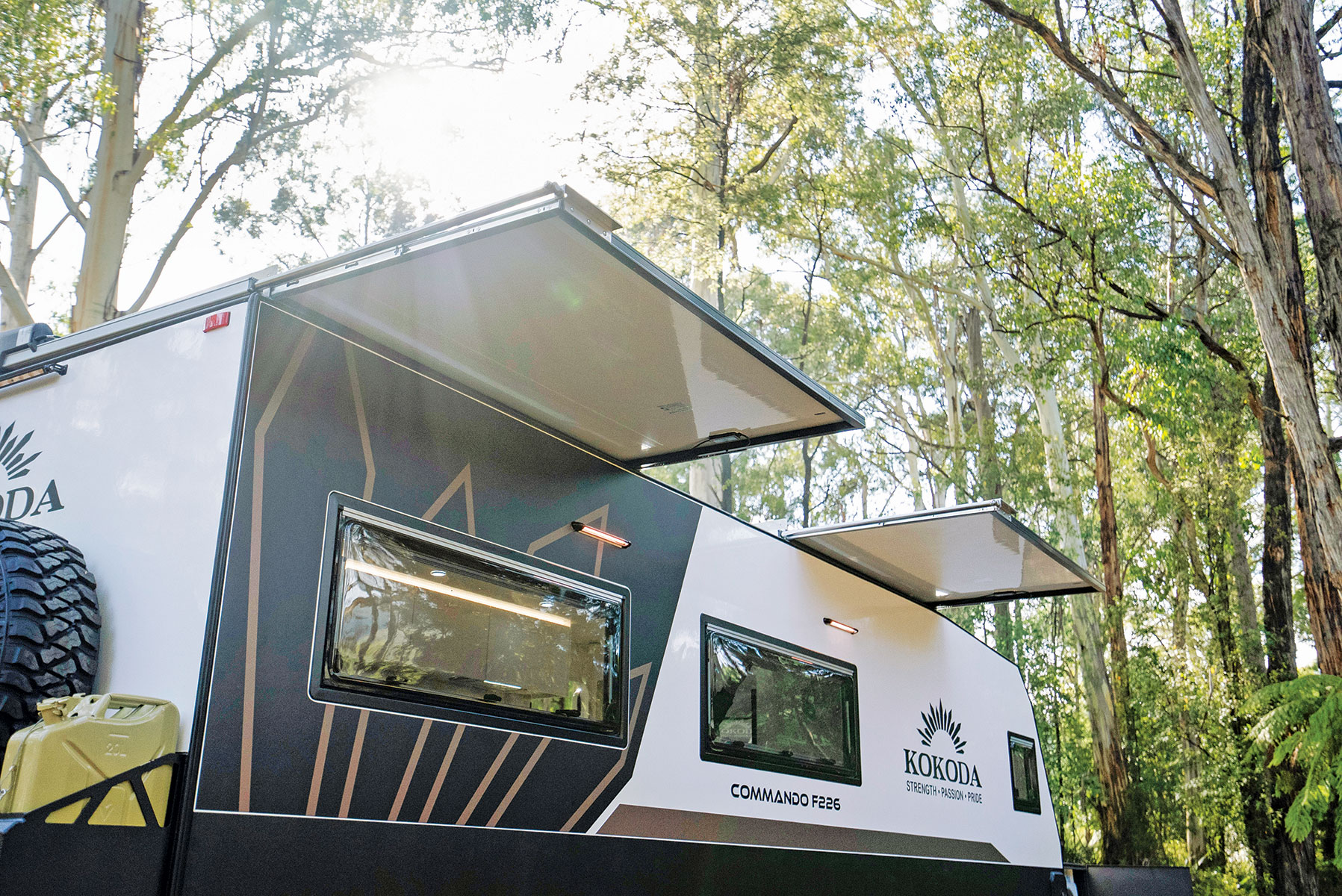
Completely gasless, the Commando has an induction cooktop built into the interior kitchen benchtop and the microwave is convection for roasting and baking. A portable induction cooktop is used in the outside kitchen.
And that's a wrap — let's see what the next year brings us!
Photography: Malcolm Street, John Hughes, Capture Factory, Cam Inniss, Graeme Neander, Glenn Marshall and John Ford
THE NEXT STEP
If you need help choosing your first caravan or are considering upgrading your existing one, check out the caravans available on TradeRVs today.
The sellers will be happy to help and answer any inquiries you may have about the products advertised for sale.
RELATED ARTICLES:
Power management for your RV part one







